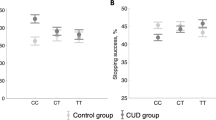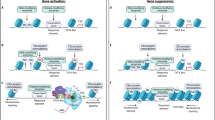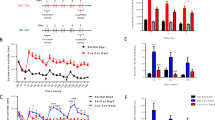Abstract
Dynorphin peptides and the κ-opioid receptor are important in the rewarding properties of cocaine, heroin, and alcohol. We tested polymorphisms of the prodynorphin gene (PDYN) for association with cocaine dependence and cocaine/alcohol codependence. We genotyped six single nucleotide polymorphisms (SNPs), located in the promoter region, exon 4 coding, and 3′ untranslated region, in 106 Caucasians and 204 African Americans who were cocaine dependent, cocaine/alcohol codependent, or controls. In Caucasians, we found point-wise significant associations of 3′UTR SNPs (rs910080, rs910079, and rs2235749) with cocaine dependence and cocaine/alcohol codependence. These SNPs are in high linkage disequilibrium, comprising a haplotype block. The haplotype CCT was significantly experiment-wise associated with cocaine dependence and with combined cocaine dependence and cocaine/alcohol codependence (false discovery rate, q=0.04 and 0.03, respectively). We investigated allele-specific gene expression of PDYN, using SNP rs910079 as a reporter, in postmortem human brains from eight heterozygous subjects, using SNaPshot assay. There was significantly lower expression for C allele (rs910079), with ratios ranging from 0.48 to 0.78, indicating lower expression of the CCT haplotype of PDYN in both the caudate and nucleus accumbens. Analysis of total PDYN expression in 43 postmortem brains also showed significantly lower levels of preprodynorphin mRNA in subjects having the risk CCT haplotype. This study provides evidence that a 3′UTR PDYN haplotype, implicated in vulnerability to develop cocaine addiction and/or cocaine/alcohol codependence, is related to lower mRNA expression of the PDYN gene in human dorsal and ventral striatum.
Similar content being viewed by others
Log in or create a free account to read this content
Gain free access to this article, as well as selected content from this journal and more on nature.com
or
Accession codes
References
Akil H, Owens C, Gutstein H, Taylor L, Curran E, Watson S (1998). Endogenous opioids: overview and current issues. Drug Alcohol Depend 51: 127–140.
Atz M, Walsh D, Cartagena P, Li J, Evans S, Choudary P et al (2007). Methodological considerations for gene expression profiling of human brain. J Neurosci Methods 163: 295–309.
Barrett JC, Fry B, Maller J, Daly MJ (2005). Haploview: analysis and visualization of LD and haplotype maps. Bioinformatics 21: 263–265.
Branch AD, Unterwald EM, Lee SE, Kreek MJ (1992). Quantitation of preproenkephalin mRNA levels in brain regions from male Fischer rats following chronic cocaine treatment using a recently developed solution hybridization assay. Brain Res Mol Brain Res 14: 231–238.
Bray NJ, Buckland PR, Owen MJ, O'Donovan MC (2003). Cis-acting variation in the expression of a high proportion of genes in human brain. Hum Genet 113: 149–153.
Bray NJ, O'Donovan MC (2006). Investigating cis-acting regulatory variation using assays of relative allelic expression. Psychiatr Genet 16: 173–177.
Buckland PR (2004). Allele-specific gene expression differences in humans. Hum Mol Genet 13: R255–R260.
Chen AC, LaForge KS, Ho A, McHugh PF, Kellogg S, Bell K et al (2002). Potentially functional polymorphism in the promoter region of prodynorphin gene may be associated with protection against cocaine dependence or abuse. Am J Med Genet 114: 429–435.
Chen JM, Férec C, Cooper DN (2006). A systematic analysis of disease-associated variants in the 3′ regulatory regions of human protein-coding genes II: the importance of mRNA secondary structure in assessing the functionality of 3′ UTR variants. Hum Genet 120: 301–333.
Claye LH, Maisonneuve IM, Yu J, Ho A, Kreek MJ (1997). Local perfusion of dynorphin A 1–17 reduces extracellular dopamine levels in the nucleus accumbens. NIDA Res Monogr 174: 113.
Dahl JP, Weller AE, Kampman KM, Oslin DW, Lohoff FW, Ferraro TN et al (2005). Confirmation of the association between a polymorphism in the promoter region of the prodynorphin gene and cocaine dependence. Am J Med Genet 139B: 106–108.
Daunais JB, McGinty JF (1994). Acute and chronic cocaine administration differentially alters striatal opioid and nuclear transcription factor mRNAs. Synapse 18: 35–45.
Daunais JB, Roberts DC, McGinty JF (1993). Cocaine self-administration increases preprodynorphin, but not c-fos, mRNA in rat striatum. Neuroreport 4: 543–546.
Gabriel SB, Schaffner SF, Nguyen H, Moore JM, Roy J, Blumenstiel B et al (2002). The structure of haplotype blocks in the human genome. Science 296: 2225–2229.
Gerfen CR (1984). The neostriatal mosaic: compartmentalization of corticostriatal input and striatonigral output systems. Nature 311: 461–464.
Gerfen CR (1992). The neostriatal mosaic: multiple levels of compartmental organization. Trends Neurosci 15: 133–139.
Glick SD, Maisonneuve IM, Raucci J, Archer S (1995). Kappa opioid inhibition of morphine and cocaine self-administration in rats. Brain Res 681: 147–152.
Horikawa S, Takai T, Toyosato M, Takahashi H, Noda M, Kakidani H et al (1983). Isolation and structural organization of the human preproenkephalin B gene. Nature 306: 611–614.
Huang W, Ma JZ, Payne TJ, Beuten J, Dupont RT, Li MD (2008). Significant association of DRD1 with nicotine dependence. Hum Genet 123: 133–140.
Hurd YL (1996). Differential messenger RNA expression of prodynorphin and proenkephalin in the human brain. Neuroscience 72: 767–783.
Hurd YL, Brown EE, Finlay JM, Fibiger HC, Gerfen CR (1992). Cocaine self-administration differentially alters mRNA expression of striatal peptides. Brain Res Mol Brain Res 13: 165–170.
Hurd YL, Herkenham M (1993). Molecular alterations in the neostriatum of human cocaine addicts. Synapse 13: 357–369.
Knight JC (2005). Regulatory polymorphisms underlying complex disease traits. J Mol Med 83: 97–109.
Koob G, Kreek MJ (2007). Stress, dysregulation of drug reward pathways, and the transition to drug dependence. Am J Psychiatry 164: 1149–1159.
Kreek MJ, Bart G, Lilly C, LaForge KS, Nielsen DA (2005). Pharmacogenetics and human molecular genetics of opiate and cocaine addictions and their treatments. Pharmacol Rev 57: 1–26.
Kreek MJ, LaForge KS, Butelman E (2002). Pharmacotherapy of addictions. Nat Rev Drug Discov 1: 710–726.
Kuzmin AV, Gerrits MA, Van Ree JM (1998). Kappa-opioid receptor blockade with nor-binaltorphimine modulates cocaine self-administration in drug-naive rats. Eur J Pharmacol 358: 197–202.
Le-Niculescu H, McFarland MJ, Mamidipalli S, Ogden CA, Kuczenski R, Kurian SM et al (2007). Convergent functional genomics of bipolar disorder: from animal model pharmacogenomics to human genetics and biomarkers. Neurosci Biobehav Rev 31: 897–903.
Levran O, Londono D, O'Hara K, Nielsen DA, Peles E, Rotrosen J et al (2008). Genetic susceptibility to heroin addiction: a candidate–gene association study. Genes Brain Behav 7: 720–729.
Mansour A, Fox CA, Meng F, Akil H, Watson SJ (1994). Kappa 1 receptor mRNA distribution in the rat CNS: comparison to kappa receptor binding and prodynorphin mRNA. Mol Cell Neurosci 5: 124–144.
McLellan AT, Kushner H, Metzger D, Peters R, Smith I, Grissom G (1992). The fifth edition of the addiction severity index. J Subst Abuse Treat 9: 199–213.
Mignone F, Gissi C, Liuni S, Pesole G (2002). Untranslated regions of mRNAs. Genome Biol 3: REVIEWS0004 Epub 2002 February 28.
Morley M, Molony CM, Weber TM, Devlin JL, Ewens KG, Spielman RS et al (2004). Genetic analysis of genome-wide variation in human gene expression. Nature 430: 743–747.
Negus SS, Mello NK, Portoghese PS, Lin CE (1997). Effects of kappa opioids on cocaine self-administration by rhesus monkeys. J Pharmacol Exp Ther 282: 44–55.
Nielsen DA, Ji F, Yuferov V, Ho A, Chen A, Levran O et al (2008). Genotype patterns that contribute to increased risk for or protection from developing heroin addiction. Mol Psychiatry 13: 417–428.
Parent A, Hazrati LN (1995). Functional anatomy of the basal ganglia. I. The cortico-basal ganglia-thalamo-cortical loop. Brain Res Brain Res Rev 20: 91–127.
Pastinen T, Ge B, Gurd S, Gaudin T, Dore C, Lemire M et al (2005). Mapping common regulatory variants to human haplotypes. Hum Mol Genet 14: 3963–3971.
Pastinen T, Ge B, Hudson TJ (2006). Influence of human genome polymorphism on gene expression. Hum Mol Genet 15: R9–R16.
Pastinen T, Hudson TJ (2004). Cis-acting regulatory variation in the human genome. Science 306: 647–650.
Purcell S, Neale B, Todd-Brown K, Thomas L, Ferreira MA, Bender D et al (2007). PLINK: a tool set for whole–genome association and population-based linkage analyses. Am J Hum Genet 81: 559–575.
Ray R, Doyle GA, Crowley JJ, Buono RJ, Oslin DW, Patkar AA et al (2005). A functional prodynorphin promoter polymorphism and opioid dependence. Psychiatr Genet 15: 295–298.
Sadée W, Dai Z (2005). Pharmacogenetics/genomics and personalized medicine. Hum Mol Genet 14: R207–R214.
Schenk S, Partridge B, Shippenberg TS (1999). U69593, a kappa-opioid agonist, decreases cocaine self-administration and decreases cocaine-produced drug-seeking. Psychopharmacology (Berl) 144: 339–346.
Sivam P (1989). Cocaine selectively increases striatonigral dynorphin levels by a dopaminergic mechanism. J Pharmacol Exp Ther 250: 818–824.
Spangler R, Unterwald EM, Kreek MJ (1993). ‘Binge’ cocaine administration induces a sustained increase of prodynorphin mRNA in rat caudate-putamen. Brain Res Mol Brain Res 19: 323–327.
Steiner H, Gerfen CR (1998). Role of dynorphin and enkephalin in the regulation of striatal output pathways and behavior. Exp Brain Res 123: 60–76.
Storey JD (2002). A direct approach to false discovery rates. J R Stat Soc, Ser B 64: 479–498.
Storey DJ, Taylor JE, Siegmund D (2004). Strong control, conservative point estimation and simultaneous conservative consistency of false discovery rates: a unified approach. J R Stat Soc B 66: 187–205.
Storey JD, Tibshirani R (2003). Statistical significance for genomewide studies. Proc Natl Acad Sci USA 100: 9440–9445.
Tao H, Cox DR, Frazer KA (2006). Allele-specific KRT1 expression is a complex trait. PLoS Genet 2: e93.
Volkow ND, Wang GJ, Telang F, Fowler JS, Logan J, Childress AR et al (2006). Cocaine cues and dopamine in dorsal striatum: mechanism of craving in cocaine addiction. J Neurosci 26: 6583–6588.
Wang JC, Grucza R, Cruchaga C, Hinrichs AL, Bertelsen S, Budde JP et al (2008). Genetic variation in the CHRNA5 gene affects mRNA levels and is associated with risk for alcohol dependence. Mol Psychiatry (15 April), doi: 10.1038/mp.2008.42, PMID: 18414406. [E-pub ahead of print].
Williams TJ, LaForge KS, Gordon D, Bart G, Kellogg S, Ott J et al (2007). Prodynorphin gene promoter repeat associated with cocaine/alcohol codependence. Addict Biol 12: 496–502.
Xie X, Lu J, Kulbokas EJ, Golub TR, Mootha V, Lindblad-Toh K et al (2005). Systematic discovery of regulatory motifs in human promoters and 3′ UTRs by comparison of several mammals. Nature 434: 338–345.
Xuei X, Dick D, Flury-Wetherill L, Tian HJ, Agrawal A, Bierut L et al (2006). Association of the kappa-opioid system with alcohol dependence. Mol Psychiatry 11: 1016–1024.
Yan H, Yuan W, Velculescu VE, Vogelstein B, Kinzler KW (2002). Allelic variation in human gene expression. Science 297: 1143.
Yuferov V, Zhou Y, LaForge KS, Spangler R, Ho A, Kreek MJ (2001). Elevation of guinea pig brain preprodynorphin mRNA expression and hypothalamic-pituitary-adrenal axis activity by ‘binge’ pattern cocaine administration. Brain Res Bull 55: 65–70.
Zhang Y, Butelman ER, Schlussman SD, Ho A, Kreek MJ (2004). Effect of the endogenous kappa opioid agonist dynorphin A(1–17) on cocaine-evoked increases in striatal dopamine levels and cocaine-induced place preference in C57BL/6J mice. Psychopharmacology (Berl) 172: 422–429.
Zhang Y, Wang D, Johnson AD, Papp AC, Sadée W (2005). Allelic expression imbalance of human mu opioid receptor (OPRM1) caused by variant A118G. J Biol Chem 280: 32618–32624.
Zimprich A, Kraus J, Woltje M, Mayer P, Rauch E, Höllt V (2000). An allelic variation in the human prodynorphin gene promoter alters stimulus induced expression. J Neurochem 74: 472–477.
Acknowledgements
We acknowledge K Bell, E Ducat, D Melia, B Ray, L Borg, P McHugh for recruiting, screening, and assessment of study subjects. We thank Daniel Perl (Alzheimer's Disease Research Center, The Mount Sinai Medical Center, New York, NY) for providing postmortem brain tissues. We are grateful to M Randesi for sequencing assistance. This work was supported by grants from the National Institutes of Health: P60-DA05130 (MJK), R01-MH79880 (MJK), R24-MH59724 (SM), AG05138 (D Perl), RR024143 (B Coller), R01- MH44292 (JO), and grants 30730057 and 30700442 from National Science Foundation of China (JO).
Author information
Authors and Affiliations
Corresponding author
Additional information
DISCLOSURE/CONFLICT OF INTEREST
All the authors, except JO, declare that, except for the income received from our primary employers, no financial support or compensation has been received from any individual or corporate entity over the past 3 years for research or professional service and there are no personal financial holdings that could be perceived as constituting a potential conflict of interests. One author, JO, wishes to declare that he personally receives book royalties from the Johns Hopkins University Press and that his laboratory receives funding from Hoffmann-La Roche Inc.
Supplementary Information accompanies the paper on the Neuropsychopharmacology website (http://www.nature.com/npp)
Rights and permissions
About this article
Cite this article
Yuferov, V., Ji, F., Nielsen, D. et al. A Functional Haplotype Implicated in Vulnerability to Develop Cocaine Dependence is Associated with Reduced PDYN Expression in Human Brain. Neuropsychopharmacol 34, 1185–1197 (2009). https://doi.org/10.1038/npp.2008.187
Received:
Revised:
Accepted:
Published:
Issue date:
DOI: https://doi.org/10.1038/npp.2008.187
Keywords
This article is cited by
-
Moderation of buprenorphine therapy for cocaine dependence efficacy by variation of the Prodynorphin gene
European Journal of Clinical Pharmacology (2022)
-
Sex differences in neural mechanisms mediating reward and addiction
Neuropsychopharmacology (2019)
-
Downregulation of the neuronal opioid gene expression concomitantly with neuronal decline in dorsolateral prefrontal cortex of human alcoholics
Translational Psychiatry (2018)
-
Dynorphin and κ-Opioid Receptor Dysregulation in the Dopaminergic Reward System of Human Alcoholics
Molecular Neurobiology (2018)
-
A Functional 3′UTR Polymorphism (rs2235749) of Prodynorphin Alters microRNA-365 Binding in Ventral Striatonigral Neurons to Influence Novelty Seeking and Positive Reward Traits
Neuropsychopharmacology (2016)



